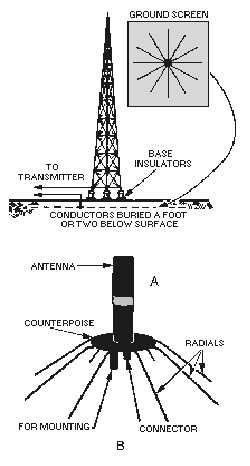4-23
vicinity of the antenna. This is the purpose of a GROUND SCREEN (figure 4-19, view A) and
COUNTERPOISE view B.
Figure 4-19.—Groundscreen and counterpoise.
The ground screen in view A is composed of a series of conductors buried 1 or 2 feet (0.3 to 0.6
meter) below the surface of the earth and arranged in a radial pattern. These conductors reduce losses in
the ground in the immediate vicinity of the antenna. Such a radial system of conductors is usually 1/2
wavelength in diameter.
A counterpoise view B is used when easy access to the base of the antenna is necessary. It is also
used when the earth is not a good conducting surface, such as ground that is sandy or solid rock. The
counterpoise serves the same purpose as the ground screen but it is usually elevated above the earth. No
specific dimensions are necessary in the construction of a counterpoise nor is the number of wires
particularly critical. A practical counterpoise may be assembled from a large screen of chicken wire or
some similar material. This screen may be placed on the ground, but better results are obtained if it is
placed a few feet above the ground.
Q20. Since the radiation pattern of a dipole is similar to that of a doublet, what will happen to the
pattern if the length of the doublet is increased?
Q21. What is the simplest method of feeding power to the half-wave antenna?


